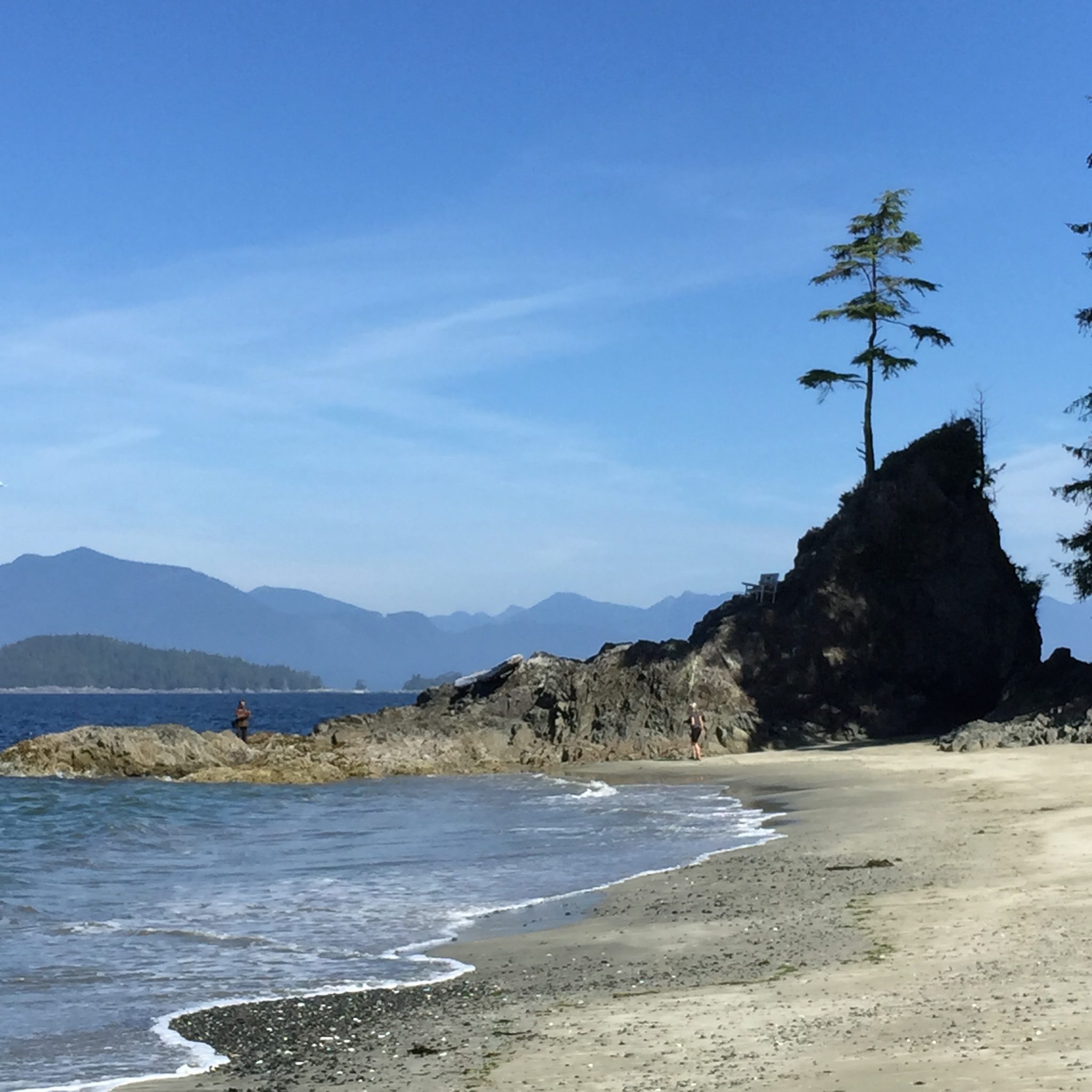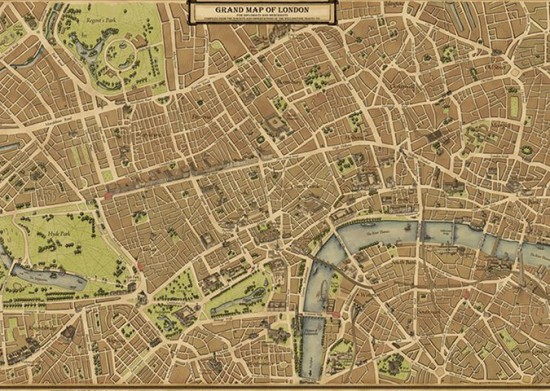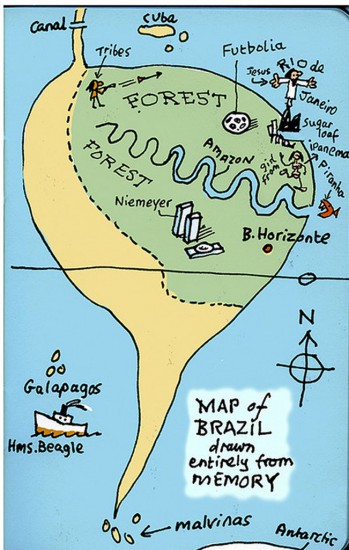There is a small sliver of space between the Staten and Governor’s Island ferry terminals where you can see the water touch the shore. Along South Street, all the way from where it converges with Whitehall to well past where it is overwhelmed by FDR Drive, there is a constant view of water, but only this solitary view of shore remains. The natural water’s edge has been replaced by more population-friendly spaces: running and biking paths, concrete and steel living spaces, dotted lines of small planters of trees, and cordoned off squares of museum-grade grass. All of these man-made spaces are unique in their own right; some are more beautiful, some seem simply more useful. But this tiny, single sliver of untouched shoreline seems valuable in a completely different way.
On most maps, this space of nearly untouched Manhattan is not mentioned or made note of. On some, it is subsumed by the combining of the two terminals into a superstructure keeping watch over Battery Park. As a passer-by, you may fail to make note of this diminutive shoreline as well. A fence railing blocks your view, trash tends to pool in the space, and the towering Beaux Arts façade of the Governor’s Island Ferry terminal distracts mightily. The surrounding area preaches an ideology of space that was long ago communicated to us through the maps that help us make sense of the areas we inhabit, whether physically or simply in our minds.
When the first Europeans set foot on the shore of North America, the cartographic intention was to define space, to create maps that showed the interior of places with their boundaries pushed to the edges of the parchment. Now, as we have built an environment of walls and dividers, our maps look quite different. No longer are the boundaries relegated to the edges, but instead are comfortably adopted as foundational building blocks to the culture and society in which we operate. Our maps are defined by the places we have built, and therefore, lend little guidance to the exploration of the wilderness.
We Separate to Define
This partitioning of space for organization and personal claim does not stop with our built environment or the artifacts we create to help navigate it; we have also turned our back on the spaces of imagination and intellect in favor of the confines of disciplines, medium specificity, and–at times–adherence to popular stylistic preferences. In partitioning the practice and study of our work, we build STATIONS. These STATIONS are in our minds. They are constraints. They are values. They are ways of seeing. But they are also in practice and function when we discuss things like disciplines and mediums.
The boundaries of disciplines are easily seen and we often find our identity as designers and teachers close tied to these boundaries. “I am a graphic designer.” I would respond to the question, as if the building or creating I do that is more closely linked to sculpture or industrial design is not an integral part of the design work I do as well.
From its root, we see that disciplines and disciplinarity are caught up with questions of the relationship between knowledge and power. The two modern usages of the term refer to 1) a particular branch of learning or body of knowledge, and 2) the maintenance of order and control amongst subordinated groups often through the threat of punishment.
Michel Foucault went so far as to say that almost the entirety of the political process from the seventeenth century centered on a structure of discipline and punishment. The discipline created neatly formed boundaries of appropriate behavior and thinking, while the punishment assured that outliers were vilified and minimized in number. “[Discipline] dissociates power from the body,” Foucault said. “On the one hand, it turns [this power] into an aptitude, a capacity, which it seeks to increase; on the other hand, it reverses the course of the energy, the power that might result from it, and turns it into a relation of strict subjection.” In short, Foucault argued that discipline and punishment provides space for an increased aptitude, but brings an increased domination of that aptitude as well.
Our disciplines are boxes. These neat and tidy spaces are well defined, have predictable outcomes, and efficient processes of evaluation. I learned design at a journalism school in the early 2000s. During this time, the communications discipline was starting to scramble around questions of adapting to changing technology and reinterpreting a changing landscape of crumbling economics and shifting business models. As an undergraduate student at this time, I had professors and professionals tell me that “Websites must work this way,” and “Magazines have to look and feel like so.” These statements were spoken and taught as fact. There was no discussion of how this might be or what complications came from this way of thought. It simply was that we were taught as Marshall McLuhan preached that the medium is the message. But if we are to get fully on board with McLuhan, we have to believe that creativity is defined only by the expressions in which we currently operate and that what we say in our work is of less value than that thing that our work uses to live. The clothes of the work are all that matters, not the individual being that wears them.
McLuhan, as my professors taught me, was extremely helpful in learning to communicate. Just as proponents of medium specificity were helpful in defining what was and was not art or painting or sculpture. We could learn the mechanism or the technically accepted means of creation, and in doing so we could do our jobs properly as communicators or artists. In other words, as long as we had the blueprint to the STATION, we could know where the train was going and did not have to worry about whom or what was on board.
Each time we give in to these myopic and mislead thought patterns, we help build, strengthen, and reinforce a boundary that places “proper” and “acceptable” work within a STATION and impedes inclusion of those who may feel outside of the definition we find comfortable and safe. And if these boundaries of new technology that McLuhan felt were so transformative matter more than the communication and expression of our work, than—in my opinion—we are all in pursuit of bad work, and we should simply create kitsch and clutter, utilizing technology as a gimmick instead of a tool.
But none of this is to say boundaries that we create through practice and craft are necessarily evil. They serve many purposes. As with a map, boundaries give us an idea of space and the internal and external of a location. They provide security for the timid and flagrant opposition for the avant-garde. They are essential to give order to a world that is confusing and constantly in flux.
We Define to Begin
I often think about a study devised by a group of psychologists sometime in the 1970s or 1980s. Using the same daycare facility, which was situated near a busy street, two groups of students were observed. One group was allowed to play on the playground adjacent to the street with no fence or boundary whatsoever. A fence was erected directly next to the street for the other group. The group without the fence stayed in small clumps, playing nervously as they huddled near the exterior of the building, while the group with the boundary played up to and on the fence. The fence was security and definition of space.
So, the answer cannot be to destroy the boundaries, to make some soupy mess of the world—that creates new problems. But we must realize these boundaries can easily impede creativity. The answer is to situate ourselves outside of these prescribed boundaries so that we may enter and exit different STATIONS as necessary. The world and our possible experiences shrink as we retreat into smaller spaces of thought and areas of practice. As teachers and artists it can be easy at times to find security in a STATION or one of the nodes in the network we see around us. As we zoom out of this solitary view, we can more easily see the entire map with all of its possibility for new connections and space for new growth. The value is the possibility of new outlooks on old projects or questions as well as changing views as we move from the interior of one STATION to another, or to new territory altogether.
We have been having this conversation for a while in art. Ever since Kant told us the frame should be ignored, we have found ourselves discussing what that edge means and where it should be. Giorgio Agamben calls this area a threshold, a spot where something is not in but not out of a place; a fully inclusive and fully exclusive space. And before him, Jacques Derrida said the frame—the parergon as he called it—was to be blown wide open, to be used as something that almost forced entrance to a new place. Regardless of the way you lean, the conversation has shifted to notice the external, the sense of other that we feel when we find ourselves in a STATION that may not be so comfortable. It forces us to look beyond the walls and move into new territory, to reject the devil we know in hopes of something more transcendent on the outside.
We Move Beyond to Explore
When I was in second grade, I had one of those experiences that get seared into your brain. We had been doing weekly exercises in pencil drawing during my second grade art class. Initial line structure, shading techniques, and perspective were behind us, and the fourth week was about drawing negative space. We were given the same still life bowl of fruit from the previous week and asked to draw it, but we were only allowed to draw the exterior lines of the shapes we saw. We were forced to see the area displaced by the object, and that lesson has stuck in my head for years.
This new territory, the unmapped STATION the surrounds the familiar, is most compelling to me for that reason. As a reluctant doctoral student, the rituals of academia are strange to me, even while I practice them. As an artist, the idea of tenure folders and promotion packets are slightly nauseating. But as a designer, the navigation of this weird landscape is a wonderful problem in need of a personal solution. In this sense, interdisciplinarity—or even extradisciplinarity—is a wonderful way to view the map of the doctoral world. By knowing the STATIONS, by understanding these nodes and what they contain, I can wander through and around them without value judgments or arguments of right or wrong. I can see them as appropriate or not. Helpful or not. Illuminating or not.
In Learning from Las Vegas, Robert Venturi writes about the intriguing views Nolli maps offer of the Las Vegas strip. These maps use black and white spaces to illuminate the things that are: things like parking lots, structures, asphalt, cars. And in the murky black negative space, we see the desert. The visual structure seems to value what is already there, while pushing the open space—this STATION of possibility—into the background.
And it is difficult work to push against the comfortable confines or see the negative spaces as possibility. We find solace in the shadows of others, and there is inclusion in the mimicking of their ideas. But I feel it is extremely important to work against the desire to spend the entirety of our lives behind these walls. So we must constantly be exploring.
We Explore to Create Anew
Guy Debord proposed the derive as one of the basic situationist practices. By passing through places through attraction we encounter new viewpoints and start breaking down or even obliterating borders. The derive isn’t just a walk toward something attractive, it entails knowing a place and knowing the boundaries that are active. The boundaries aren’t necessarily walls or border crossings or anything tangible; the boundaries are often attitudes, perceptions, and preconceived notions. For a derive to have any level of success, you have to know the place you find yourself at some level and proceed forward despite whatever may keep you from progress to new knowledge or renewed sight.
I see Walter Benjamin when I read about the derive, especially in regard to his supposedly unfinished manuscript of the Arcades Project. I say supposedly because it seems to work so well as a functional object of what he was doing himself. The work is a wandering, sometimes dramatically unclear, exploration of the places he frequented; a sprawling map of the city he knew yet felt he knew nothing of at the same time. It is impossible to consume from cover to cover. The way in which it is compiled almost forces the reader to explore in his or her own way. Perhaps you begin with the early chapters and find yourself trailing away, resuming the conversation once Benjamin moves out of the common places and into areas that are unfamiliar to you. But you find yourself wandering through its pages, taking passing notice of small things and building a picture of a city in your mind.
So in this same way, I wander back to that sliver of space between the ferry terminals.






